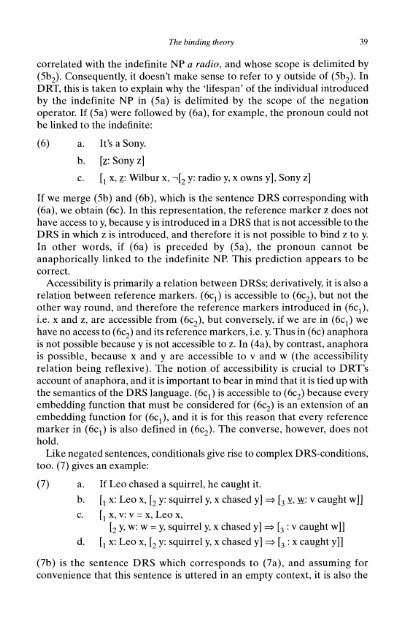Presuppositions and Pronouns - Nijmegen Centre for Semantics
Presuppositions and Pronouns - Nijmegen Centre for Semantics
Presuppositions and Pronouns - Nijmegen Centre for Semantics
You also want an ePaper? Increase the reach of your titles
YUMPU automatically turns print PDFs into web optimized ePapers that Google loves.
The binding theory 39<br />
correlated with the indefinite NP a radio, <strong>and</strong> whose scope is delimited by<br />
(5b 2 ). Consequently, it doesn't make sense to refer to y outside of (5b 2 ). In<br />
DRT, this is taken to explain why the 'lifespan' of the individual introduced<br />
by the indefinite NP in (5a) is delimited by the scope of the negation<br />
operator. If (5a) were followed by (6a), <strong>for</strong> example, the pronoun could not<br />
be linked to the indefinite:<br />
(6) a. It's a Sony.<br />
b. [z: Sony z]<br />
c. [1[ x x, z: Wilbur x, -,b -[ 2 y: radio y, x owns y], Sony z]<br />
If we merge (5b) <strong>and</strong> (6b), which is the sentence DRS corresponding with<br />
(6a), we obtain (6c). In this representation, the reference marker z does not<br />
have access to y, because y is introduced in a DRS that is not accessible to the<br />
DRS in which z is introduced, <strong>and</strong> there<strong>for</strong>e it is not possible to bind z to y.<br />
In other words, if (6a) is preceded by (5a), the pronoun cannot be<br />
anaphorically linked to the indefinite NP. This prediction appears to be<br />
correct.<br />
Accessibility is primarily a relation between DRSs; derivatively, it is also a<br />
relation between reference markers. (6c 1 ) is accessible to (6c 2 ), but not the<br />
other way round, <strong>and</strong> there<strong>for</strong>e the reference markers introduced in (6c 1 ),<br />
i.e. x <strong>and</strong> z, are accessible from (6c 2 ), but conversely, if we are in (6c 1 ) we<br />
have no access to (6c 2 ) <strong>and</strong> its reference markers, i.e. y. Thus in (6c) anaphora<br />
is not possible because y is not accessible to z. In (4a), by contrast, anaphora<br />
is possible, because x <strong>and</strong> y yare accessible to v <strong>and</strong> w (the accessibility<br />
relation being reflexive). The notion of accessibility is crucial to DRT's<br />
account of anaphora, <strong>and</strong> it is important to bear in mind that it is tied up with<br />
the semantics of the DRS language. (6c 1 ) is accessible to (6c 2 ) because every<br />
embedding function that must be considered <strong>for</strong> (6c 2 ) is an extension of an<br />
embedding function <strong>for</strong> (6c 1 ), <strong>and</strong> it is <strong>for</strong> this reason that every reference<br />
marker in (6c 1 ) is also defined in (6c 2 ). The converse, however, does not<br />
hold.<br />
Like negated sentences, conditionals give rise to complex DRS-conditions,<br />
too. (7) gives an example:<br />
(7) a. If Leo chased a squirrel, he caught it.<br />
b. [1[ 1 x: Leo x, [ b 2 y: squirrel y, x chased y] => ~ [ b 3 y, 1Y: w: v caught w]]<br />
c. [ 1 h x, v: v = x, Leo x,<br />
[ by, 2 w: w = y, squirrel y, x chased y] ~ =» [3 [ 3 : v caught w]]<br />
d. [1[ x x: Leo x, [ b 2 y: squirrel y, x chased y] => ~ [ b 3 : x caught y]]<br />
(7b) is the sentence DRS which corresponds to (7a), <strong>and</strong> assuming <strong>for</strong><br />
convenience that this sentence is uttered in an empty context, it is also the














